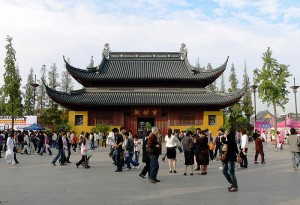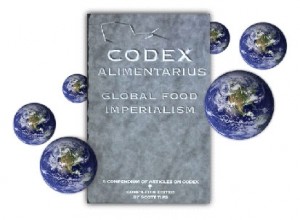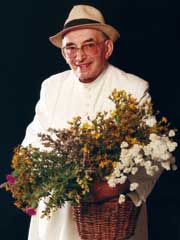Pflanzen&Gewürze
Samarkand to New York: The Book of Jewish Food
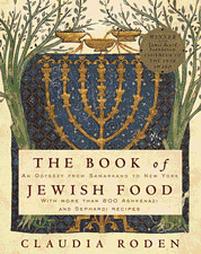
Syrian Jews (Arabic: يهود سوريون) are Jews who inhabit the region of the modern state of Syria, and their descendants born outside Syria. Syrian Jews derive their origin from two groups: from the Jews who inhabited the region of today’s Syria from ancient times (known as Musta’arabi Jews, and sometimes classified as Mizrahi Jews, a generic term for the Jews with an extended history in the Middle East or North Africa); and from the Sephardi Jews (referring to Jews with an extended history in the Iberian Peninsula, i.e. Spain and Portugal) who fled to Syria after the expulsion of the Jews from Spain (1492 CE).
There were large communities in Aleppo and Damascus for centuries, and a smaller community in Qamishli on the Turkish border near Nusaybin. In the first half of the 20th century a large percentage of Syrian Jews emigrated to the U.S., Central and South America and Israel. Most of the remaining Jews left in the 28 years following 1973, due in part to the efforts of Judith Feld Carr, who claims to have helped some 3,228 Jews emigrate; emigration was officially allowed in 1992. Today there are about 25 Jews in Syria, all of them living in Damascus. The largest Syrian Jewish community is located in Brooklyn, New York and is estimated at 75,000 strong. There are smaller communities elsewhere in the United States and in Latin America. Read More: > HERE <
Jewish Cuisine is the collection of cooking traditions of the Jewish people. It is a diverse cuisine that has evolved over many centuries, shaped by Jewish dietary laws (kashrut) and Jewish Festival and Sabbath traditions. Jewish cooking has also been influenced by the economics, agriculture, and culinary traditions of the many countries where Jewish communities have existed since Late Antiquity. Kashrut and holiday traditions provide unifying elements in the cuisine, while geographic dispersion has led to a diversity of styles. Read More: > HERE <
Claudia Roden, author of The Book of Jewish Food, has done more than simply compile a cookbook of Jewish recipes–she has produced a history of the Jewish diaspora, told through its cuisine. The book’s 800 recipes reflect many cultures and regions of the world, from the Jewish quarter of Cairo where Roden spent her childhood to the kitchens of Europe, Asia, and the Americas. Both Ashkenazi and Sepharidic cooking are well represented here: hallah bread, bagels, blintzes, and kugels give way to tabbouleh, falafel, and succulent lamb with prunes, which are, in turn, succeeded by such fare as Ftut (Yemeni wedding soup) and Kahk (savory bracelets).
The Book of Jewish Food: An Odyssey from Samarkand to New York: Interwoven throughout the text are Roden’s charming asides–the history of certain foods, definitions (Kaimak, for instance, is the cream that rises to the top when buffalo milk is simmered), and ways of preparing everything from an eggplant to a quince. In addition, Roden tells you everything you’ve ever wanted to know about Jewish dietary laws, what the ancient Hebrews ate, and the various holidays and festivals on the Jewish calendar. Detailed sections on Jewish history are beautifully illustrated with archival photographs of families, towns, and, of course, food. The Book of Jewish Food is one that any serious cook–Jewish and non-Jewish alike–would gladly have (and use often) in the kitchen. Buy this Book: > HERE <
From Publishers Weekly – As the biblical echo of the title indicates, this collection is as instructive and comprehensive as a textbook. Roden (Mediterranean Cookery, etc.) divides the territory in two parts: „The Ashkenazi World“ and „The Sephardi World.“ She chronicles the lives of Jews all over the world in short segments on unusual Jewish communities past and present, such as those of Salonika, Greece, and China. These sections, and the many other notes on subjects ranging from the New York Deli to salt herring are gems. Recipes are numerous and diverse: Yellow Split Pea Soup with Frankfurters, Pumpkin Tzimmes, Small Red Kidney Beans with Sour Plum Sauce, Cold Stuffed Vine Leaves, and Fish Balls in Tomato Sauce. Some highlights include the chapter on Sephardic breads (Algerian Anise Bread, North African Sweet Breads with Nuts and Raisins) and the one on Ashkenazic desserts (Mandelbrot, Hanukah Jam Doughnuts). All of this can be a little overwhelming at times (and, as Roden acknowledges in the introduction, many Jewish foods simply reflected the cuisines of the places where Jews were living rather than their own specific culture). Yet with few omissions (e.g., the instructions for making pasta specify rolling out the dough „as thin as possible“ but don’t explain how), Roden proves a practiced, reliable guide.
Copyright 1996 Reed Business Information, Inc.
- DIE VEDISCHE KOCHKUNST <
- Ayurvedische Ernährung < Jahreszeiten in Rythmen der Bioenergien <
- Meet Krishna Food, friends, fans at fb <
- DRBA Realm Buddhist Ass. – Food for Thought <
- Meet East Meets West Music, friends, fans at fb <
- Meet International Society of Hildegard von Bingen Studies at fb <
- Meet Council for a Parliament of the World’s Religions (CPWR)at fb <
TAOISM – Taoist Tai Chi Society™
Taoism (or Daoism) refers to a variety of related philosophical and religious traditions that have influenced Eastern Asia for more than two millennia, and have had a notable influence on the western world particularly since the 19th century. The word 道, Tao (or Dao, depending on the romanization scheme), literally translates as, „path“ or „way“ (of life), although in Chinese folk religion and philosophy it carries more abstract meanings. Taoist propriety and ethics emphasize the Three Jewels of the Tao: compassion, moderation, and humility, while Taoist thought generally focuses on nature, the relationship between humanity and the cosmos (天ä��相应), health and longevity, and wu wei (action through inaction), which is thought to produce harmony with the Universe. Read More: > HERE <
Tao (pronounced „Dow“) can be roughly translated into English as path, or the way. It is basically indefinable. It has to be experienced. It „refers to a power which envelops, surrounds and flows through all things, living and non-living. The Tao regulates natural processes and nourishes balance in the Universe. It embodies the harmony of opposites (i.e. there would be no love without hate, no light without dark, no male without female.)“
The founder of Taoism is believed by many religious historians to be Lao-Tse (604-531 BCE), whose life overlapped that of Confucius (551-479 BCE). (Alternative spellings: Lao Tze, Lao Tsu, Lao Tzu, Laozi, Laotze, etc.). However other historians suggest that he is a synthesis of a number of historical figures. Others suggest that he was a mythical figure. Still others suggest that he lived in the 4th century BCE.
He was searching for a way that would avoid the constant feudal warfare and other conflicts that disrupted society during his lifetime. The result was his book: Tao-te-Ching (a.k.a. Daodejing). Others believe that he is a mythical character.
A Taoist priest (Sai Kong) chanting the scripture in Hokkien for the Nine Emperor Gods Festival in Tao Bo Keong, Penang.
Taoism started as a combination of psychology and philosophy but evolved into a religious faith in 440 CE when it was adopted as a state religion. At that time Lao-Tse became popularly venerated as a deity. Taoism, along with Buddhism and Confucianism, became one of the three great religions of China. With the end of the Ch’ing Dynasty in 1911, state support for Taoism ended. Much of the Taoist heritage was destroyed during the next period of warlordism. After the Communist victory in 1949, religious freedom was severely restricted. „The new government put monks to manual labor, confiscated temples, and plundered treasures. Several million monks were reduced to fewer than 50,000“ by 1960. 3 During the cultural revolution in China from 1966 to 1976, much of the remaining Taoist heritage was destroyed. Some religious tolerance has been restored under Deng Xiao-ping from 1982 to the present time.
Taoism currently has about 20 million followers, and is primarily centered in Taiwan. About 30,000 Taoists live in North America; 1,720 in Canada (1991 census).
Taoism has had a significant impact on North American culture in areas of „acupuncture, herbalism, holistic medicine, meditation and martial arts…
The Yin Yang symbol: This is a well known Taoist symbol. „It represents the balance of opposites in the universe. When they are equally present, all is calm. When one is outweighed by the other, there is confusion and disarray.“ One source explains that it was derived from astronomical observations which recorded the shadow of the sun throughout a full year. The two swirling shapes inside the symbol give the impression of change — the only constant factor in the universe. One tradition states that Yin (the dark side) represents the breath that formed the earth. Yang (the light side) symbolizes the breath that formed the heavens.
One source states: „The most traditional view is that ‚yin‘ represents aspects of the feminine: being soft, cool, calm, introspective, and healing… and „yang“ the masculine: being hard, hot, energetic, moving, and sometimes aggressive. Another view has the ‚yin‘ representing night and ‚yang‘ day.
Another source offers a different definition: A common misconception in the west is that „…yin is soft and passive and yang is hard and energetic. Really it is yang that is soft and yin that is hard, this is because yang is energetic and yin is passive. Yin is like a rock and yang is like water or air, rock is heavy and hard and air is soft and energetic.“
Allan Watts, describes the yin and yang as negative and positive energy poles: „The ideograms indicate the sunny and shady sides of a hill….They are associated with the masculine and the feminine, the firm and the yielding, the strong and the weak, the light and the dark, the rising and the falling, heaven and earth, and they are even recognized in such everyday matters as cooking as the spicy and the bland.“
However, since nothing in nature is purely black or purely white, the symbol includes a small black spot in the white swirl, and a corresponding white spot in the black swirl.
Ultimately, the ‚yin‘ and ‚yang‘ can symbolize any two polarized forces in nature. Taosts believe that humans often intervene in nature and upset the balance of Yin and Yang. Full Article: http://www.religioustolerance.org
- www.wudanggongfu.com
- Dein Ayurveda Net:…. Articles on TCM <
- WU XING, 5 Elements, Roots of Chinese Medicine <
- Meet Wudang Conception, studies, friends at fb <
- Meet International Taoist Tai Chi Society, friends and studies at fb <
- Meet Traditional Chinese Medicine, studies, friends and fans at fb <
- Meet Lao Tzu, studies, friends, fans at fb <
- Council for a Parliament of the World’s Religions (CPWR) <
Mother´s Day- Flowers for Human Rights
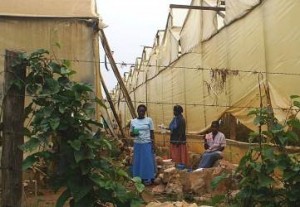
Green Shopping Guide Österreich: http://bewusstkaufen.at
NATIONAL GEOGRAPHIC – GREEN GUIDE
Lotus Flower – Symbol of Purity and Great Beauty!
The modern Mother’s Day is celebrated on various days in many parts of the world, most commonly in May, though also in March, as a day to honor mothers and motherhood. In the United States it was nationally recognized as a holiday in 1914 after a campaign by Anna Jarvis. In some countries, it follows the old traditions of Mothering Sunday. Read More: > HERE <
Mother’s Day (U.S.) is an annual holiday that recognizes mothers, motherhood and maternal bonds in general, as well the positive contributions that they make to society. In the United States, it is celebrated on the second Sunday in May. Read More: > HERE <
Flowers around the globe – Are you aware that the cut flower you buy in the supermarket or at your florist might have travelled thousands of kilometres to please you at home or in the office? Indeed, an increasing share of flowers which are sold in Europe is grown in countries close to the equator.
Do you wonder why? Around the equator conditions for growing flowers are more favourable than in Europe. Those countries don’t have cold winters, they constantly have 12 hours daylight and they have fertile soil. Labour is cheap and, labour and environmental laws are not as strict as in Europe, or at least, they are not enforced.
Are you concerned about the latter? We, too, are. That’s why we have started a campaign to raise awareness on labour rights, workers‘ health, and environmental protection in the flower industry. Join us and be part of the change.
The campaign „Fair Flowers for Human Rights“ – Non-governmental organisations from Austria, Belgium, Germany, and Czech Republic have jointly started a campaign to raise awareness on human rights violations and environmental pollution by the global flower industry. The campaign is supported by the Zimbabwean Non-Governmental Organisation Kunzwana and the Uganda Workers‘ Education Association.
The campaign targets consumers, flower traders and local authorities and it aims at changing their consumption and purchasing patterns towards ensuring that flowers are produced in socially and environmentally sound conditions.
As means to reach our targets we will produce information material, organise exhibitions and speakers‘ tours of flower workers, produce a movie, conduct workshops and lobby politicians. We will be present at various public events. You can read more on the specific actions in each country if you click on the logos of the campaign partners below. http://www.flowers-for-human-dignity.org/09/index.php/the-campaign.html
Fair trade roses for Mother´s Day & Human Rights
Da die heimische Schnittblumenproduktion die Nachfrage am österreichischen Markt nicht befriedigen kann, werden fast zwei Drittel der in Österreich verkauften Blumen aus Ländern des Südens importiert. Jährlich sind das zum Beispiel gut 80 Millionen Rosen. Auf den Blumenfarmen in Kenia, Uganda, Simbabwe, Ecuador und Kolumbien arbeiten zum Großteil Frauen, vielfach unter katastrophalen Arbeitsbedingungen.
Besonders vor dem Muttertag und den Valentinstag leisten sie Überstunden bis spät in die Nacht, oft werden diese nicht oder nicht vollständig bezahlt. Die Frauen berichten von gesundheitlichen Schäden aufgrund der Arbeit mit hoch giftigen Pestiziden und mangelndem Arbeitsschutz, auf manchen Farmen auch von sexueller Belästigung.
„Für die Frauen bedeutet die Arbeit auf den Blumenfarmen ein wichtiges Einkommen. Besonders in Lateinamerika arbeiten viele allein erziehende Mütter auf den Farmen. Sie benötigen dringend einen angemessenen Lohn, um sich und ihre Kinder adäquat ernähren zu können.“, berichtet Sophie Veßel, Koordinatorin der Kampagne „ Fair Flowers – mit Blumen für Menschenrechte “ bei der Menschenrechtsorganisation FIAN Österreich.
FIAN setzt sich seit vielen Jahren für die Rechte der ArbeiterInnen auf Schnittblumenfarmen weltweit ein. In Betrieben, die mit dem Gütesiegel Flower Label Program (FLP) zertifiziert wurden, werden Arbeits- und Menschenrechte eingehalten. Die Arbeitszeiten sind in langfristigen Verträgen geregelt, Überstunden werden angemessen bezahlt. Entsprechende Kleidung schützt die ArbeiterInnen vor den Chemikalien. Hoch giftige Pestizide dürfen überhaupt nicht eingesetzt werden. Für Frauen ist insbesondere wichtig, dass ihnen bezahlter Mutterschutzurlaub gewährt wird, sie während der Schwangerschaft geschont werden und sexuelle Belästigung nicht geduldet wird.
Daher empfehlen FIAN und die Volkshilfe Österreich, beim Blumenkauf zu Blumen der Gütesiegel Flower Label Program (FLP) und FAIRTRADE zu greifen. „Blumen, die unter fairen Arbeitsbedingungen produziert wurden, sind ein besonders sinnvolles Geschenk. Denn sie unterstützen den Kampf gegen Ausbeutung von ArbeiterInnen.“, meint Josef Weidenholzer, Präsident der Volkshilfe Österreich. „Mit dem Kauf solcher Blumen können Sie doppelte Freude schenken. Der eigenen Mutter und der Blumenarbeiterin.“ Dass die Blumen nicht mit hoch giftigen Pestizid en belastet sind, trägt sicher zusätzlich zur Freude der Beschenkten bei!
FLP-Blumen verschiedener Sorten finden Sie im ausgewählten österreichischen Fachhandel, FAIRTRADE-Rosen in Supermärkten und im Fachhandel.
- AFRICAN TRADITIONAL MEDICINE <
- Weitere Informationen:
- www.fian.at (FLP-HändlerInnenliste)
- www.volkshilfe.at
- www.flowers-for-human-dignity.org
- www.fairflowers.at (FLP-HändlerInnenliste)
- The New 2008 Constitution of Ecuador <
- Meet Human Rights Campain, friends at fb <
- Meet FAIR TRADE certificied, friends at fb <
- Meet Human Rights Watch, friends at fb <
- Meet National Geographic, Green Guide, friends, fans at fb <
IRRI Rice Research Institute & Conference
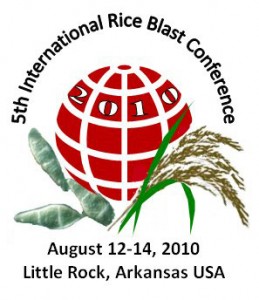
TRAD. FOOD, AYURVEDA, BIODIVERSITY
The Rice Price Crisis Prevention
The International Rice Research Institute (IRRI) is an autonomous, non-profit, agricultural research and training organization with offices in more than ten nations. The Institute’s main goal is to find sustainable ways to improve the well being of present and future generations of poor rice farmers and consumers while at the same time protecting the natural environment. Most of IRRI’s research is done in cooperation with the national agricultural research and development institutions, farming communities, and other organizations of the world’s rice producing nations. Read More: > HERE <
Rice is the seed of a monocot plant Oryza sativa. As a cereal grain, it is the most important staple food for a large part of the world’s human population, especially in East, South, Southeast Asia, the Middle East, Latin America, and the West Indies. It is the grain with the second highest worldwide production, after maize („corn“).Read More: > HERE <
The years 2007–2008 saw dramatic increases in world food prices, creating a global crisis and causing political and economical instability and social unrest in both poor and developed nations. Systemic causes for the worldwide increases in food prices continue to be the subject of debate. Initial causes of the late 2006 price spikes included droughts in grain-producing nations and rising oil prices. Read More: > HERE <
IRRI´s MISSION – To reduce poverty and hunger, improve the health of rice farmers and consumers, and ensure environmental sustainability through collaborative research, partnerships, and the strengthening of national agricultural research and extension systems.
The Cereal Knowledge Bank (CKB) is the world’s leading repository of extension and training materials related to cereal and cereal production. The CKB was launched in January 2008 and is managed by the International Rice Research Institute (IRRI) and International Maize and Wheat Improvement Center (CIMMYT) as a service to people working to improve the well-being of poor cereal farmers and consumers.
> FREE BOOK: Asian rice bowls: the returning crisis? – Prabhu L. Pingali <
5th International Rice blast Conference, caused by Magnaporthe oryzae, remains one of the most destructive rice diseases worldwide. In the three years since the 4th International Rice Blast Conference (IRBC) was held in Changsha, Hunan, China, rapid progress has been made in a wide range of research topics on the biology, genomics, host-pathogen interactions, resistance, and disease management. On behalf of the 5th IRBC organizing committee, we cordially invite you to attend this exciting meeting. > CONFERENCE DETAILS <
Invitation to the 3rd International Rice Congress – It is our privilege and pleasure to welcome you to the 3rd International Rice Congress (IRC) to be held 8 – 12 November 2010 at the Vietnam National Convention Center, Hanoi, Vietnam. The event is hosted by the Ministry of Agriculture and Rural Development (MARD), Vietnam, and jointly organized by the International Rice Research Institute (IRRI) and AsiaCongress Events Management Co. Ltd (ACE). www.ricecongress.com
HILDEGARD OF BINGEN & FAMOUS SPELT CURE – Hildegard medicine is based on the wisdom of the saintly Hildegard (1098-1179), abbess of Bingen. The great mystic, composer and healer is considered to be the first important naturopath and herbalist of the Middle ages. Her teachings, based on the harmony between body and soul, are reflected in today’s holistic approaches to prevention and healing. Hildegard medicine taps the available healing forces of nature to treat illness by restoring disrupted balance. Hildegard emphasized nutrition, primarily with use of spelt, a type of grain; detoxification, by fasting or bloodletting; and the use of remedies from plant, animal and mineral sources. Her writings offer recipes for 12000 such remedies, which apply to the most diverse symptoms and diseases.
Spelt – According to Hildegard of Bingen, spelt is the „most nutritious grain“, providing „right flesh and right blood“. She recommends breads and soups containing spelt to purify the blood, strengthen the nerves and heal intestinal disorders. You can find spelt at most health food stores. The Treatment – First comes an examination of the person as a whole, not just symptoms but lifestyle and temperament. The nutritional therapy consists of suggesting foods that are specifically adapted to the individual patient. Then purifying procedures, such as bloodletting, are recommended. Finally, stimulating herbal remedies are prescribed. The goal of Hildegard medicine – Hildegard medicine is a means of regulating the systems of the body in relation to one another. The goal is to reverse the disruption of the natural balance in the body, which is the cause of the illness. This effect is achieved through appropriate nutrition, detoxification and nature based remedies. The viewpoint of mainstream medicine – Some aspects of Hildegard medicine cannot be explained scientifically. However, holistic approaches to illness have been successful for a wide range of patients, who respond well to treatments that include more than chemical targeting of symptoms.
- Das International Rice Research Institute (IRRI) www.payer.de <
- TSAMPA, HIMALAYAN CHILDREN, CEREALS <
- Meet Tibetan Tsampa, friends, fans at fb <
- Meet Int.Society of Hildegard von Bingen Studies, friends at fb <
- Meet International Year of Biodiversity 2010, friends, fans at fb <
- http://en.wikipedia.org/wiki/2007%E2%80%932008_world_food_price_crisis
JATROPHA BIOFUELS – THE TRUE COSTS
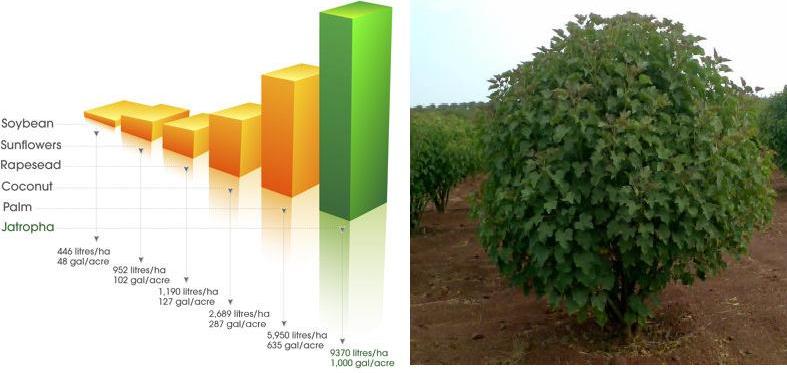
Biofuels: Biodevastation, Hunger & False Carbon Credits
JATROPHA Agrartreibstoff der Armen ?
Jatropha biofuels: the true cost to Tanzania
Jatropha is a genus of approximately 175 succulent plants, shrubs and trees (some are deciduous, like Jatropha curcas L.), from the family Euphorbiaceae. The name is derived from (Greek iatros = physician and trophe = nutrition), hence the common name physic nut. Jatropha is native to Central America and has become naturalized in many tropical and subtropical areas, including India, Africa, and North America. Originating in the Caribbean, Jatropha was spread as a valuable hedge plant to Africa and Asia by Portuguese traders.
GOLDMANN SACHS recently cited Jatropha curcas as one of the best candidates for future biodiesel production.However, despite its abundance and use as an oil and reclamation plant, none of the Jatropha species have been properly domesticated and, as a result, its productivity is variable, and the long-term impact of its large-scale use on soil quality and the environment is unknown. Read More: > HERE <
A Carbon credit is a generic term meaning that a value has been assigned to a reduction or offset of greenhouse gas emissions. Carbon credits and markets are key components of national and international attempts to mitigate the growth in concentrations of greenhouse gases (GHGs). One carbon credit is equal to one ton of carbon dioxide, or in some markets, carbon dioxide equivalent gases.Read More: > HERE <
GRAIN is a small international non-profit organisation that works to support small farmers and social movements in their struggles for community-controlled and biodiversity-based food systems. Our support takes the form of independent research and analysis, networking at local, regional and international levels, and fostering new forms of cooperation and alliance-building. Most of our work is oriented towards, and carried out in, Africa, Asia and Latin America.
GRAIN’s work goes back to the early 1980s, when a number of activists around the world started drawing attention to the dramatic loss of genetic diversity on our farms — the very cornerstone of the world’s food supply. We began doing research, advocacy and lobbying work under the auspices of a coalition of mostly European development organisations. That work soon expanded into a larger programme and network that needed its own footing. In 1990, Genetic Resources Action International, or GRAIN for short, was legally established as an independent non-profit foundation with its headquarters in Barcelona, Spain.
Welcome to our website – Jatropha Farming Opportunity, Jatropha Planting Opportunity for Nursery Growers , Carbon Credits & Government, Subsidization , Farmers Cash Flow Analysis
We know that energy is a matter of national security as the volatile Middle East affects the world supply with most developing countries struggling with heavy oil import costs. The price of Crude Fossil oil is touching 100 US $ per barrel and expected to touch 150 mark within two years. As such for many countries, the question of trying to achieve greater energy independence one day through the development of biofuels has become one of ‘when’ rather than ‘if,’ and, now on a near daily basis, a biofuels programme is being launched somewhere in the developing world.
Exporters of – Jatropha, Neem, Cotton, Caster, Karanj Seeds, Oils, Cake, Bio-Diesel Products, All Seeds, Natural Herbals, Himalayan Herbs, Herbal Extract, Spices, Ayurvedic, All Agriculture Products, Coir Fibre Mate, Marble & Granite etc.
We are engaged in sourcing of natural herbals & seeds like JATROPHA, NEEM CASTER, COTTON SEEDS, OILS & CHEAKS and all kind of Himalayan Herbs, herbal Extract, Spice, Ayurvedic, Unani for our buyers.
Consequently, we have a very good grip in the most prominent markets and sourcing better quality product for our buyers in a reasonable price. We have number of buyers from every corner of national and international markets, they are willing to get material from India as well as other countries also. We have provided good quality, good service and fast communications in every time to our buyers. Kindly send us your valuable offer.
Thanks N Regards:
For ATHULYA EXPORTS
(K.N. AJIKUMAR)
PROPRIETOR
- SAVE MOTHER EARTH <
- TRAD. MEDICINE AND PRIMARY HEALTH CARE – RAINFOREST MEDICINE <
- PALMOIL – Biofuel, Climate Change, Food, etc. <
- Indian companies also enter biofuel business in Ghana, Project for Himachal, etc.<
- Goldmann Sachs Wellness Exchange <
- http://en.wikipedia.org/wiki/Goldman_Sachs <
- Meet GLOBAL CONCERN, friends, fans & studies at fb <
- Meet Human Rights Watch, friends, fans at fb <
- Meet Transparency International, friends, fans at fb <
- Meet COP16 UN Climate Change Conference Mexico 2010 <
- Meet 100 Million Voices for a Real Climate Deal in Mexico 2010 <
Codex Alimentarius – Food Book & Food Code
Codex Alimentarius on Honey in trad. Ayurveda
www.anhcampaign.org – codex alimentarius
The Codex Alimentarius (Latin for „food code“ or „food book“) is a collection of internationally recognized standards, codes of practice, guidelines and other recommendations relating to foods, food production and food safety. Its name derives from the Codex Alimentarius Austriacus. Its texts are developed and maintained by the Codex Alimentarius Commission, a body that was established in 1963 by the Food and Agriculture Organization of the United Nations (FAO) and the World Health Organization (WHO). The Commission’s main aims are stated as being to protect the health of consumers and ensure fair practices in the international food trade. The Codex Alimentarius is recognized by the World Trade Organization as an international reference point for the resolution of disputes concerning food safety and consumer protection. Read More: > Here <
The Codex Alimentarius (Latin for „food code“ or „food book“) is a collection of internationally recognized standards, codes of practice, guidelines and other recommendations relating to foods, food production and food safety. Its name derives from the Codex Alimentarius Austriacus. Its texts are developed and maintained by the Codex Alimentarius Commission, a body that was established in 1963 by the Food and Agriculture Organization of the United Nations (FAO) and the World Health Organization (WHO). The Commission’s main aims are stated as being to protect the health of consumers and ensure fair practices in the international food trade. The Codex Alimentarius is recognized by the World Trade Organization as an international reference point for the resolution of disputes concerning food safety and consumer protection.
> Codex Alimentarius utube Channel <
Vortrag Dr. Rima E. Laibow und Major General Albert N. Stubblebine von der Natural Solutions Stiftungbei der Konferenz der Anti-Zensur- Koalition am Samstag den 21. Februar 2009 in Chur in der Schweiz.
The Codex Alimentarius officially covers all foods, whether processed, semi-processed or raw, but far more attention has been given to foods that are marketed directly to consumers. In addition to standards for specific foods, the Codex Alimentarius contains general standards covering matters such as food labeling, food hygiene, food additives and pesticide residues, and procedures for assessing the safety of foods derived from modern biotechnology. It also contains guidelines for the management of official (i.e., governmental) import and export inspection and certification systems for foods.
The Codex Alimentarius is published in Arabic, Chinese, English, French and Spanish. Not all texts are available in all languages.
- ALSO SEE: http://www.guardian.co.uk
- Traditional Food, Ayurveda, Biodiversity <
- Meet Campaign Codex Alimentarius, friends, fans at fb <
- Meet Codex Alimentarius, friends, studies at fb <
- Meet Wellness Uncovered Forum, studies, friends at fb <
- Meet NaturalNews.com, studies, friends at fb <
NaturalNews.com is an independent news resource that covers the natural health and wellness topics that empower individuals to make positive changes in their personal health. NaturalNews offers uncensored news that allows for healthier choice.
PALMOIL – Biofuel, Climate Change, Food, etc.
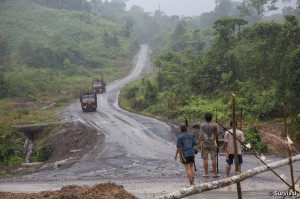
> Penan armed with blowpipes block road as logging trucks owned by the Shin Yang company approach. <
> Rainforest Information Center <
> SURVIVAL INTERNATIONAL -PALM OIL <
> THE ECOLOGIST – PALM OIL, SUSTAINABLE PALMOIL ? <
> 9th Session UN Permanent Forum on Indigenous Issues <
> Indigenous Peoples Issues/Resources – Palm Oil <
Palm oil is an edible plant oil derived from the pulp of the fruit of the oil palm Elaeis guineensis. It should not be confused with palm kernel oil, which is derived from the kernel (seed) of Elaeis guineensis, or with coconut oil, which is derived from the kernel of the coconut palm (Cocos nucifera). Palm oil is naturally reddish because it contains a high amount of beta-carotene (though boiling palm oil destroys the beta-carotene, rendering the oil colourless. Read More: > HERE <
Deforestation occurs for many reasons: trees or derived charcoal are used as, or sold, for fuel or as a commodity, while cleared land is used as pasture for livestock, plantations of commodities, and settlements. The removal of trees without sufficient reforestation has resulted in damage to habitat, biodiversity loss and aridity. It has adverse impacts on biosequestration of atmospheric carbon dioxide. Deforested regions typically incur significant adverse soil erosion and frequently degrade into wasteland.
Disregard or ignorance of intrinsic value, lack of ascribed value, lax forest management and deficient environmental law are some of the factors that allow deforestation to occur on a large scale. In many countries, deforestation is an ongoing issue that is causing extinction, changes to climatic conditions, desertification, and displacement of indigenous people.Read More: > HERE <
Biofuels threaten lands of 60 million tribal people – Demand for biofuels is destroying tribal peoples’ land and lives, according to indigenous representatives at the United Nations Permanent Forum on Indigenous Issues (UNPFII), meeting currently in New York.
A report presented to the UNPFII refers to ‘increasing human rights violations, displacements and conflicts due to expropriation of ancestral lands and forests for biofuel plantations.’ One of the report’s authors, UNPFII chairperson Victoria Tauli-Corpuz, has said that if biofuels expansion continues as planned, 60 million indigenous people worldwide are threatened with losing their land and livelihoods.
Palm oil is one of the most destructive crops used for biofuels. Millions of indigenous people in Malaysia have already been affected by palm oil plantations, and millions more in Indonesia, where over 6 million hectares of oil palm have been planted, mostly on indigenous territory. In Colombia, thousands of families, many of them indigenous, have been violently evicted from their land because of palm oil plantations and other crops.
Malaysia, Indonesia and Colombia all plan to expand their palm oil plantations. Indonesia has announced plans for plantations in Borneo, projected to displace up to 5 million indigenous people, and 5 million hectares, much of it indigenous land, has been set aside for palm oil in Papua. Colombia is planning 6.3 million hectares of plantations, which could affect more than 100 indigenous communities.
‘If the government take our land, what will we have left?’ an indigenous Papuan leader said in an interview with Survival. ‘If there is a plantation, our land will be destroyed.’
Other crops for biofuels include sugar cane, soy, corn, manioc and jatropha, a plant native to Central America. The > Guarani < in Brazil have lost much of their land to sugar cane cultivation, while the government in India is targeting 13.5 million hectares of what it calls ‘wasteland’, much of which is actually indigenous land.
Survival’s director, Stephen Corry, said today, ‘The biofuels boom doesn’t just have consequences for the environment, global food prices or orang-utans – it’s having a devastating effect on tribal people too. The companies feverishly promoting this industry have been perfectly willing to push aside tribal people in their hunger for land.’
The Amazon Rainforest is the world’s greatest natural resource – the most powerful and bio-actively diverse natural phenomenon on the planet. Yet still it is being destroyed just like other rainforests around the world. The problem and the solution to rainforest destruction are both economic. Rainforests are being destroyed worldwide for the profits they yield – mostly harvesting unsustainable resources like timber, for cattle and agriculture, and for subsistence cropping by rainforest inhabitants. However, if land owners, governments and those living in the rainforest today were given a viable economic reason NOT to destroy the rainforest, it could and would be saved. Thankfully, this viable economic alternative does exist. Many organizations have demonstrated that if the medicinal plants, fruits, nuts, oils and other resources like rubber, chocolate and chicle, were harvested sustainably – rainforest land has much more economic value than if timber were harvested or if it were burned down for cattle or farming operations. Sustainable harvesting of these types of resources provides this value today as well more long term income and profits year after year for generations to come.
The Amazon Rainforest has long been a symbol of mystery and power, a sacred link between humans and nature. It is also the richest biological incubator on the planet. It supports millions of plant, animal and insect species – a virtual library of chemical invention. In these archives, drugs like quinine, muscle relaxants, steroids and cancer drugs are found. More importantly, are the new drugs still awaiting discovery – drugs for AIDS, cancer, diabetes, arthritis and Alzheimer’s.
Many secrets and untold treasures await discovery with the medicinal plants used by shamans, healers and the indigenous people of the Rainforest Tribes. So alluring are the mysteries of indigenous medical knowledge that over 100 pharmaceutical companies and even the US government are currently funding projects studying the indigenous plant knowledge and the specific plants used by native shamans and healers.
Long regarded as hocus-pocus by science, indigenous people’s empirical plant knowledge is now thought by many to be the Amazon’s new gold. This untold wealth of the indigenous plants are the true wealth of the rainforest – not the trees. Rich in beneficial nutrients, phytochemicals and active constituents, the rainforest Indians and Indigenous People have used them for centuries for their survival, health and well-being. Yet extracting these secrets from the jungles is no easy task and sadly, this state of affairs may not last long enough into the future for man to unlock all their secrets. Tragically, rainforests once covered 14% of the earth’s land surface; now they cover a mere 6%.
In less than 50 years, more than half of the world’s tropical rainforests have fallen victim to fire and the chain saw and the rate of destruction is still accelerating. Unbelievably, over 200,000 acres of rainforest are burned every day in the world. That is over 150 acres lost every minute of every day. Experts estimate that at the current rate of destruction, the last remaining rainforests could be consumed in less than 40 years. Experts also estimate that we are losing 130 species of plants, animals and insects every single day as they become extinct from the loss of rainforest land and habitats. How many possible cures to devastating diseases have we already lost? > FULL ARTICLE , PLANT DATA BASE, RAINFOREST SUPPORT <
Biodiversity, Heinrich Böll Stiftung – In conclusion, it appears increasingly clear that there are some forms of new energy investment, (both fossil-fuel and so-called “renewable”) that are particularly damaging to the local environment and communities and to our climate. For these reasons, they should be considered too high risk to pursue – especially in developing countries with very weak political and environmental governance. Eni’s plans to develop tar sands and oil palm in Congo fall into this category.
- Download full version of Study > „Energy Futures ? < Eni´s investment in> tar sands (extra heavy oil) < and palm oil in the Congo Basin“ (PDF, 4 MByte, 41 Pages).
- INTERVIEW – Keine Entwarnung: Bedrohung für Gletscher im Himalaya ist real > HERE < & ( IPCC) The Intergovernmental Panel on Climate Change Report.
- BÖLL – GOING GREEN – THE FUTURE HAS BEGUN NOW<
Heinrich Theodor Böll (December 21, 1917 – July 16, 1985) was one of Germany’s foremost post-World War II writers. Böll was awarded the Georg Büchner Prize in 1967 and the Nobel Prize for Literature in 1972. Read More: > HERE <

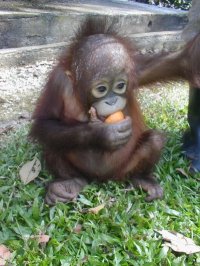
The demand for palm oil is forecast to double by 2020. To achieve that production increase, 1,160 new square miles will have to be planted every year for 20 years. Indonesia has 26,300 square miles more forest land officially allocated for new oil palm plantations; Malaysia has almost 3,000 square miles more. The expected thousands of square miles of new plantings on the islands of Sumatra and Borneo could kill off the remaining orangutans, rhinos, and tigers.
- Important: Please look at the following links to learn more about Palm Oil and the effect on the Orangutans: An article on the effects of Palm Oil: http://www.guardian.co.uk/environment/2007/apr/04/energy.indonesia
- All interesting Links: : > SAVE THE ORANG UTAN / facebook <
- Some Facts from … > DONT PALM US OFF < :
- Palm oil is found about 40 percent of the food products on our shelves and its rampant cultivation is destroying the Orangutan’s habitat at an alarming rate.
- The United Nations has warned that Orangutans could be extinct within a generation if we don’t act quickly.
- Once palm oil is labelled, consumers can actually drive a market for proper certified sustainable palm oil because they can demand it of manufacturers.
- Watch the Don’t Palm Us Off campaign video and send this page link to your friends!
- Palm Oil in Chocolate, Greenpeace Canada <
- SAVE MOTHER EARTH, SAVE GANGA <
- PALM OIL BLOG AND VIDEOS <
- Economic Benefits ? <
- Saving Rainforest with medical plants <
- Heinrich Böll Stiftung – Tar Sands and Palm Oil in Congo <
- Meet Dont Palm us off , friends fans, at fb <
- Meet Indigenous Peoples Issues and Resources, friends, fans at fb <
- Meet Survival International friends, fans at fb <
- Meet Global Concern, studies, friends, fans at fb <
- Meet The Ecologist, studies, friends, fans at fb <
- Meet Nobel´s Women Initiative, friends, fans at fb <
- Meet ALL PALM OIL GROUPS, Friends, (APOC) Palm Oil Comm.<
Herbal Priests – Roots of Medicine Europe
> INSTITUTE FOR INTERNATIONAL MEDICINE <
> KRÄUTERLEXIKON, HEILPFLANZEN <
by Subhuti Dharmananda
Hermann-Josef Weidinger (* als Heinrich Anton Weidinger 16. Jänner 1918 in Riegersburg; † 21. März 2004 in Waidhofen an der Thaya) war Prämonstratenser-Chorherr, Missionar und in Österreich als „Kräuterpfarrer Weidinger“ bekannt.
Die Bürgerschule besuchte er jenseits der Grenze in Frain (Vranov) an der Thaya im damals deutschsprachigen Teil Südmährens. Mit 18 Jahren fasste Weidinger, der sich bereits als Bub gerne im Kräutergarten seines Onkels aufgehalten hatte, den Entschluss, Missionar zu werden. Nach der Matura an der Aufbauschule in Horn entschloss er sich zum Dienst in der Mission und trat in den Orden der Salesianer Don Boscos ein. Nach kurzer Vorbereitung und Sprachschulung in Unterwaltersdorf und in Italien kam er 1938 in die Republik China, wo er Philosophie und Theologie studierte und das Buchdruckerhandwerk erlernte.
Im damals noch portugiesischen Macao gründete er einen Verlag. Als Übersetzer bekannter Werke ins Chinesische machte er sich einen Namen. Nach medizinischen Kursen lernte Weidinger als Assistent eines Militärarztes die chinesische Naturheilkunde kennen. Read More: > HERE <
Kräuter-Pfarrer Künzle – Mit seinen pflanzlichen Natur-Arzneien konnte Kräuter-Pfarrer Künzle viele Kranke heilen – oft auch dann noch, wenn die Schulmedizin bereits am Ende ihres Lateins angelangt war. Kein Wunder also, dass ihn nicht nur Menschen aus seiner Heimat aufsuchten, sondern auch Adelige aus aller Herren Länder, wie der König von Serbien, der Maharadscha von Idore aus Indien und viele andere mehr.
Als Kräuter-Pfarrer Künzle auch Zustimmung von Kaiser Franz-Josef erhielt, fand er sogar Anerkennung bei jenem Ärztekollegium, das seine Arbeit verbieten wollte. Mit seinem enormen medizinischen Wissen und seiner herausragenden Intelligenz (8 Sprachen) konnte er schliesslich alle davon überzeugen, dass viele Gesundheitsprobleme mit seinen pflanzlichen Präparaten erfolgreich behandelt werden können. Er gilt somit als der Wegbereiter der modernen Phyto-Therapie (Pflanzenheilkunde) und war ein Vorreiter der Ganzheitsmedizin. …und heute sind seine phyto-therapeutischen (pflanzlichen) Produkte aktueller denn je. Mehr lesen: www.kp-kuenzle.ch
Swiss Priest Johann Künzle: > Major European Herbs < by Subhuti Dharmananda, Ph.D
Kräuterpfarrer Hermann-Josef Weidinger wurde 1918 in Riegersburg geboren, mit 18 Jahren entschloss er sich, Missionar zu werden. Er trat in das Missionshaus Unterwaltersdorf ein, maturierte 1938 und fuhr noch im selben Jahr nach China. Anfangs arbeitete er im Pressebereich. Nach medizinischen Kursen lernte Weidinger als Assistent eines Militärarztes die chinesische Naturheilkunde kennen. Eine Malaria-Erkrankung beendete jedoch abrupt die Tätigkeit im Reich der Mitte. Weidinger trat in das Prämonstratenserstift Geras ein und wurde Pfarrer in Harth. Nach dem Tod des damaligen Kräuterpfarrers Rauscher im Jahr 1979 übernahm Weidinger die Leitung des in Karlstein ansässigen Vereins der Freunde der Heilkräuter.
Heilkraft der Pflanzen seit Jahrhunderten bekannt – Schon Hildegard von Bingen beschäftigte sich mit der Heilkraft der Pflanzen. Die Heilkraft der Pflanzen war im Volk bekannt, in den Klöstern aber wurden sie sowohl intensiviert, als auch kultiviert.
Hermann-Josef Weidinger, better known as Herbal Priest Weidinger, who died on Sunday, March 21, 2004, at the age of 86. He had studied European herbalism in his youth and traveled to China as a missionary in 1938, where he learned also of their herbal system; he returned from China in 1953. He continued his work as an herbalist and proponent of healthy lifestyle, writing some 40 books on natural health care. Until recently, he and 37 assistants prepared and prescribed herbal remedies in Karlstein, Austria, at the Paracelsus House Nature Cure Center.
Tracing the history of European herbology – In all cultures, the origins of herbal medicine are lost in the mists of time. There is little doubt that humans used herbs for healing well before anything could be written about them. At some point in an advancing culture, written documents become the repository for knowledge that had been passed on from one generation to the next. Among the earliest such documents are those describing the religious beliefs of the people and those describing the medical practices.
Many authorities recognize Hippocrates (460-375 B.C.) as the „father of medicine“ for the European tradition. He had little interest in the use of herbs. The primary focus of the Hippocratic School of Medicine was diet and nutrition and a reliance on calm, moderate living. These are the same foundations that herbalists such as Künzle put forth as the basis for healing .
A summation of the Hippocratic approach was presented by Erwin Ackerknecht, in his 1968 book (revised from the 1955 edition) A Short History of Medicine, as relayed below. Naturopathic physicians today will recognize the opening description as the one adopted in the definition of their profession. Reference is then made to the conditions of apepsis and pepsis, referring, basically, to inability to properly digest (apepsis) or ability to properly digest (pepsis), which is likened to cooking of the food in the stomach, relying on an innate heat.
To students of Asian medicine, this is a near perfect echo of teachings from India and China about the source of disease and the resolution of disease via invigorating this digestive fire and promoting the healthy function of the digestive system.
The great philosopher Aristotle (384-322 B.C.) was the son of a medical man and a medical man himself, but his main influence on the development of European medicine was through his student, Theophrastus (380-287 B.C.), called the „father of botany.“ He was the first known author in Europe (and the rest of the world) of a classification system for plants with accompanying comments about their medicinal properties. He described about 450 different medicinal plants. However, this text has not come down through history, and is only noted in later commentaries.
The first document of herbal medicine to attain the status of a medical classic in the European tradition was by Dioscorides (40-90 A.D.). Known as Materia Medica, a fifth century reproduction still exists, complete with botanical illustrations that were apparently added to the original text (carefully preserved in Vienna). > HISTORIC ISLAMIC PLANT MEDICINE <
Dioscorides was a surgeon accompanying the armies of Nero. He traveled far, collected much information, and gained considerable medical experience as he went. His work was later adopted by Muslim physicians, leading to the development of Unani medicine (Greek medicine as retained in the Islamic tradition).
Contributions of Herbalist Priests in Central Europe – Father Sebastian Kneipp (1821-1897) of Bavaria, is recognized as one of the leading contributors to the modern field of natural healing. He advocated exposure to nature: sunlight, baths, fresh air, and dips in cold water, eating natural foods (rather than processed foods), and having a positive mental attitude, as a means of recovering health, and this is an origin of the „spa“ movement in central Europe that remains vibrant today. He became convinced of the efficacy of this approach when, at the age of about 21, he suffered from tuberculosis and cured himself by these methods-particularly the „water therapy“-which he was said to have found described in the Vatican archives, though it may have been from another church library. After becoming a priest, he began making recommendations for sick parishioners.
Kneipp had a strong influence on the development of naturopathy and herbal therapeutics in America. In 1892, one of those who sought out Father Kneipp’s help was Benedict Lust, a German who had immigrated to America, but then returned home after contracting tuberculosis. He was cured using Kneipp’s method of water therapy (along with healthy diet and herbs) and became convinced of its general usefulness. He returned to America to promote „Kneippism,“ starting schools, societies, magazines, health food stores, and sanitariums. Lust utilized the name naturopathy to describe the basic approach, and founded the American Naturopathic Association and the American School of Naturopathy.
Künzle had learned from Kneipp as well as from other priest-herbalists (such as Father Ludwig, mentioned in his autobiography) and his work stimulated considerable interest in herbalism in Europe during the first half of the 20th century.
In turn, Kneipp and Künzle both influenced the Austrian Hermann-Josef Weidinger (1918-2004). He had studied European herbalism in his youth and traveled to China as a missionary, where he lived from 1938 to 1953, and learned of their herbal system from a Buddhist monk and also while working with an army doctor.
He returned from China due to illness and continued his work as an herbalist, writing numerous books on natural health care. Until recently, he and 37 assistants prepared and prescribed herbal remedies in Karlstein, Austria, at the Paracelsus House Nature Cure Center.
FULL ARTICLE: > Tracing the history of European herbology <
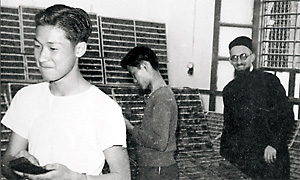
Kräuterpfarrer Weidinger in China
- ARGE-TCM.AT < Fortbildungsdiplom renomierte Links und mehr…
- www.cmjournal.org The official journal of the International Society for Chinese Medicine
- www.kp-kuenzle.ch/links.html – Info about European Medicines Agency
- Bauerngarten < , trad. organic farming
- www.international.natur-im-garten.at
- KRÄUTER ANNO 1625 <
- ARCHE NOAH, Traditional Food, Organic Seeds <
- http://en.wikipedia.org/wiki/Sebastian_Kneipp
- Articles about > Hildegard of Bingen <
- Articles about > TCM <
- Article > Traditionelle abendländische Medizin <
- International Society of Hildegard von Bingen Studies <
- Meet Islamic Medicine the cure for every desease at fb <
NaturalNews.com is an independent news resource that covers the natural health and wellness topics that empower individuals to make positive changes in their personal health. NaturalNews offers uncensored news that allows for healthier choice.
ORGANIC INDIA, TULSI THE HOLY BASIL
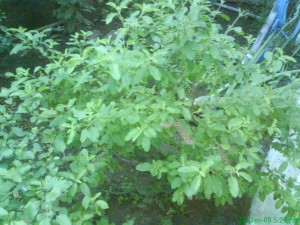
( Organic Health & Wellness Products )
> TULSI KÖNIGIN DER HEILKRÄUTER <
Ocimum tenuiflorum (also tulsi, tulasÄ�) is an aromatic plant in the family Lamiaceae. It is an erect, much branched subshrub 30-60 cm tall with hairy stems and simple opposite green leaves that are strongly scented. Leaves have petioles, and are ovate, up to 5 cm long, usually slightly toothed. Flowers are purplish in elongate racemes in close whorls. There are two main morphotypes cultivated in India—green-leaved (Sri or Lakshmi tulsi) and purple-leaved (Krishna tulsi). There is also a variety of Ocimum tenuiflorum which is used in Thai cuisine, and is referred to as Thai holy basil, or kha phrao (กะเพรา) not be confused with „Thai Basil“, which is a variety of Ocimum basilicum . Read more: > HERE <
Tulsi is native throughout the Old World tropics and widespread as a cultivated plant and an escaped weed.
ORGANIC INDIA means absolute commitment to quality . All our products are 100% organic, pure and natural, because you want the best for your family and so do we.
The guiding principles of our company are health and happiness for all beings and great respect for the Divine Mystery of Mother Nature who selflessly sustains humanity and naturally provides us all with a bounty of nourishing foods and healing herbs.
Free Articles and Tips on Healthy Living, Stress Relief, Sustainability and More – Subscribe to the ORGANIC INDIA Newsletter NOW!!
FUTURE OF FOOD: http://cookingupastory.com
-
NaturalNews.com is an independent news resource that covers the natural health and wellness topics that empower individuals to make positive changes in their personal health. NaturalNews offers uncensored news that allows for healthier choice.
-
Cooking Up a Story (CUpS) is an online television show and blog about people, food, and sustainable living. The Show offers a variety of original short-form programming.
YOGA, TREE AND OUR UNIVERSE
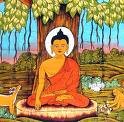
The Originar of Hatha-Yoga
Tree is the highest evolved form in plant kingdom. Man is the highest evolved species in Animal kingdom. Mushrooms are the best fungi visible on this planet. There is commonality of forms among all these highest evolved forms among different type of life-forms -Tree-like structure.Man is a cerebro-spinal being sheathed within a fleshy body. Most evolved form of cell is neuron that mediates consciousness is Tree-like structure. Surprisingly, most powerful thing that mankind achieved viz. atom bomb , produce Tree-like clouds after exploding on the surface.
Tree-like structure in Nature!
One can find out where else do Tree-like structure in nature exist. Pliny, the Younger linked the eruption of Vesuvius eruption in 79 A.D. with Italian umbrella pine. It is now an established scientific fact that the most powerfur process within earth, volcanic plumes that move inside earth is umbrella-shaped with a column & umbrella spinning about vertical axis( Tree-like). The most terrible force on the surface of the earth are the Tornados which are again Tree-like shapes with a column & an umbrella. Tree-like shape is found in other very powerful phenomena like lightening flashes, electric sparks, river delta, snowflakes, coral .
Tree-like structure is characteristics of every visceral system. Biologists trace this form in the mosses, lichens, shrubs, root system, mammalian lung bronchioles, cells of nervous system, veins & arteries forming cardio-vascular system. Wheresoever there are branching system, that invariably culminate in a Tree-like structure.
Tree & Fractal Geometry
In last fortnight, a brilliant paper was published in ‚Advances in Soft Computing“, under the title“Algorithms for Tree-like Structure Generation“ by Anna Romanowska, a neuro-anatomist et al. The team characterised Tree-like structure as that form which bifurcates but do not form any cycles. The team picked up the concepts of fractal geometry & fused with algorithms to create a Recurrent Algorithm. Self-similarity and repetition of sequence( iteration) is generated by a bifurcating cascade. The team concluded that if living system are generated recurrently, complex organic structures like roots, bronchial system in lungs emerge.
Now that an algorithm for Tree-like structure has been generated, it will be feasible in a decade to manufacture on mass scale silicon bronchial/ cardio-vascular/ neural system .
Before the advent of Fractal geometry by Benoit Mandelbrot during 1970s, the question of Tree-like structure had perturbed many a great minds. Hisao Honda of University of Kyoto published a paper on “ Description of the Form of Trees by the parameters of the Tree-like body“ in the Journal of Theoretical Biology, May, 1971. Honda concluded that Tree architecture maximizes flow access. He found stastitical similarity in living & non-living world, among branching in living system & geological & geophysical system.
- Meet Swami SIVANANDA friends, yoga, studies, at facebook <
- Meet Bhagavad Gita friends, yoga, studies at facebook <
- Meet Patanajali friends, yoga, studies at facebook <
- Meet Buddhism, friends, studies, Medicine at facebook <
- Meet Paramahansa Yogananda friends, groups, studies at fb <
- Meet Raja Yoga, Friends, Group, studies at facebook <
- Meet IYENGAR (B.K.S.), Yoga, Friends, Studies, Groups at fb<
- Meet Swami Vivekananda, Yoga, Studies, Friends, Groups at fb<
- Meet Bhagavad Gita, Yoga, Studies, Friends, Groups at fb <
- Meet Ramana Maharshi Groups, Friends, Studies, Fans at fb<
- Meet Hinduism, Groups, Friends at facebook <
- Meet Kashmir Hinduism, Studies, Friends at facebook <
- Meet Shaktism and Devi the Godess at facebook <
- Meet Saundaryalahari: Wave of Bliss by Shankaracharya at fb <
- Meet Arsha Vidya Gurukulam, Studies, Friends, Fans, at fb <
- Meet Advaita Vedanta,Groups,Studies, Vivekananda at fb <
- Meet Yogi Yogendra Nath, Studies about Goraksha at fb <
- Meet Jaya Kula and the three ways of Practicing tantra at fb <
- Meet VASTU, Friends, and Study Groups at facebook <
- Meet Jyotish, Friends, and Study Groups at facebook <
- Meet Sacred Geometry at facebook <
- READ MORE HERE:
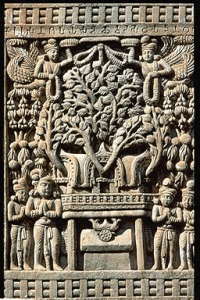
Morphic field & Morphic Resonance!
Tree-form is found in lower kingdom of Animal as well as Fungi. Jelly fishes or the polyp, these are invariably shaped like Trees. The colonies of proliferating marine organism replicate this form. It is interesting that jellyfishes which have no neurons & man with maximum neurons are essentially same in shape. Great Scottish biologist, Sir D’Arcy Thompson wrote in 1917 „On Growth and Form“, to analyse patterns & shapes in nature. His erudite tradition sd being carried by Rupert Sheldrake, a British biologist. He has done extensive work on the concept of morphic field & morphic resonance. By morphic resonance, he explains the influence of Like upon Like by which a connection among similar fields is established. He has shown in his work example of crystallization. It is very difficult to crystallize a new compound for the first time. Once it is done, a morphic field emerge. It is easier next time if someone does elsewhere in the world. There is a cumulative influence & it gets easier & easier to crystallize the compound. There is an accelerated rate of crystallization . Similarly, in learning among rats, this phenomena has been experimentally confirmed. It is difficult for a rat to pass through a maze for the first time. But, once a rat does this, another rat elsewhere does it much easily. And with each learning , there is spontaneous spread of new habits. For Sheldrake, evolutionary spread of new habit is not genetic but depends on a kind of collective memory due to morphic resonance.
This can be easily comprehended in case of human. It was very tough to manufacture clock or VCD or computer. More people are manufacturing, easier it is getting to manufacture. Watches, transistora & VCDs are now cottage industry. Who knows in future, robotics will emerge as similar kind of easily handled industry and there will be garages in every nook & corner of city to repair robots or even remodell robots by neighbourhood mechanic.
Sheldrake further proposes the concept of the „Memory of Nature“. Habits of nature depend on non-local similarity reinforcement. Through morphic resonance, the pattern of activity in self-organizing system are influenced by similar patterns in the past. He brings back the idea of Carl Jung‘ collective unconscious.
Examining Growth of Tree-Form!
I find the concept of morphic resonance appealing. That can explain this frequent recurrnce of similar pattern in nature. If we ponder over the shape of DNA & its future. The fluid around earth’s inner core creates a helical movement and generates magnetic field. The geodynamo of the earth is a self-replicating system that help explain the continuity of magnetism in earth’s core , otherwise it would have dissipated within 20,000 years. Now, the transformatory biological molecule,DNA, is helical as well as self-replicating. Within geo-physical processes, we know that Tree-like plumes are created. Now, this geophysical structure resonates throughout future evolution of biological world. For every plume within, there is a tornado on the surface. This first form of powerful process recurs at the level of the most developed categories at various levels, may it be fungi, or plants or animals or cells. And, that form recurs in even man-made powerful processes like atomic explosions.Upon visualizing this sequence, I can very well predict that the most successful biological robots or most efficient spaceship for planetary travels would have Tree-like architecture. Our Discovery spaceship is a poor materialization of that critical architecture.
Tree & bifurcation!
This Tree-like structure itself is generated by recurrent self-similarity which results due to behaviour of a dynamic system. Now, the chaos theorists have worked out very well that how in a dynamic system , a stage of crisis is set in and at the point , there are two possibilities for the system to transform. Sometimes, the system oscillates between two possibilities as found in certain chemical clocks extensively investigated by Nobal laureate Ilya Prigogine.Most of the times, the branches grow further and then bifurcate. This is iteration of self-similarity that later results into Tree-like structures.
If this kind of bifurcaing iteration is fundamental to our changing Reality which is dynamic, and there is morphic resonance, one can draw the contours of this phenomena of emergence of Tree-like structure at a higher level.
End of biological evolution!
The bifurcation, that determines DNA-replication to cell-division, has finally achieved its destiny in the biological world in the form of Human beings. We are the highest biological form and the biological evolution has now concluded. There is no further scope of biological evolution beyond us.Perfect biological bifurcating branching system has been achieved. Our lungs, our cardio-vascular system, neural system .. everything has emerged as mere consequence of cascading bifurcation. Surprisingly, we have greater number of most evolved cells viz. neurons (200 billions) which themselves replicate own form at macrolevel. The cerebro-spinal system is a magnified neuron. We are the only animal to walk on 2 legs. Penguins do perform but lack other binarities. We have two legs, two hands, two nostrils, two ears, two testicles, two mammary glands, two eyes, two kidneys, two hemispheres in brain, two atrium, two ventricles in heart, two excretory points, two lips, two jaws. Our thinking pattern is also binary. Our categories are in twos- good/bad, high/low,sacred/profasne, self/other… We donot yet understand that this duality in thought is rooted in hemispheric brain or in fractal geometry. There is no more bifurcation & branching possible in bodily architecture of human beings. This is the end-point of biological evolution. Now, mankind is on verge of developing biological robots & higher order machine consciousness therby imbuing consciousness to physical world bypassing the biological evolution. We are becoming the co-creator of the Universe as well as agent to accelerate self-consciousness of physical matter in the universe.
Trees are our cousin!
Now, the issue of Tree-like structure resonates into our collective psyche. Tree is the source of wisdom, healing, nourishment, power. Bible myth has Tree . Newton discovered moodern science sitting under an apple Tree. Buddha discovered non-theistic self-awareness sitting under a peepul Tree. In Tibetan tradition, powerful meditation requires visualizing Tree of lineage with various Gurus on different branches. These kind of visualization has transformative effect on our consciousness. In every culture, Tree occupies a significant position in rituals & mythology. We feel special feeling with Tree. Our romantic mood, our wisdom, contemplative mood, aesthetic mood.. orbit around physical & metaphoric Tree. Tree have power to transmit some kind of healing power to us. Tree are the source of healing body through fruits & herbal medicine . Tree heals our body, mind as well as soul, if any. The processes involved may be a kind of morphic reonance that vitalizes self-similar cardio-vascular, respiratory & neural system.Trees are our morphic cousins. We feel guilty & hurt when trees are cut or when those are under environmental threat.
Future?
One thing is certain. Future robots & spaceships which would be most efficient to survive would have Tree-like architecture. We would have very little to do with blooming of age of nanotechnology, biotechnology & Artificial intelligence. Successful creation of algorithm for Tree-like structure has made it more likely that artificial human organs can be manufactured at industrial level. When death will be conquered after successful download of Memories & large scale diffusion of bionics, We would have enough time to resonate with biological Trees in solitude & steer mankind towards a spiritual evolution as biological evolution from DNA-pathway has reached a dead end!
(Niraj,1.11.2009)
Galangal, TCM, Western Plants in Medicine

> GALGANT , HILDEGARD´s MEDICINE <
> LI SHI ZEN PRIVATUNIVERSITÄT <
> Zingiber off. – Naturheilkunde EU(+Yoga) <
> TCM mit westlichen Pflanzen <
> Kleiner Galgant, Chinesisch 山奈 <
The Galangal plant (Galanga, Blue Ginger) is a rhizome with culinary and medicinal uses. (Lao: ຂ່າ „Kha“; Thai: ข่า „Kha“; Malay: lengkuas (Alpinia galangal); Traditional Mandarin: 南薑 or 高良薑; Simplified Mandarin: 南姜 or 高良姜; Cantonese: lam keong, 藍薑; Vietnamese: Riềng).
It is used in various oriental cuisines (for example in Thai cuisine Tom Yum soups and Dtom Kha Gai, Vietnamese Huenian cuisine (Tre) and throughout Indonesian cuisine, for example, in Soto). Though it is related to and resembles ginger, there is little similarity in taste. Alpinia galanga is also known as Chewing John, Little John Chew and galanga root. It is used in African-American folk medicine. Read More: > Here <
Lesser galangal or Alpinia officinarum (synonym Languas officinarum) is a plant in the ginger family and native to China, growing mainly on the southeast coast. It is also grown in India which is the second largest exporter of the rhizome. The rhizome was widely used in ancient and medieval Europe.
The rhizome is smaller than greater galangal. The skin and the flesh are reddish brown whereas greater galangal has light yellow or white flesh. It was preferred to greater galangal because of its stronger, sweeter taste with notes of cinnamon. Its use in Europe has dramatically declined, however, and is now only used in Eastern Europe. It is used in Russia for flavoring vinegar and the liqueur Nastoika. It is still used as a spice and medicine in Lithuania and Estonia. In Central Asia, Tartars prepare a kind of tea that contains it. The spice used in South Eastern Asia which often goes by the name of „Lesser Galangal“ is actually Kaempferia galanga.
The word lesser galangal properly refers to Alpinia officinarum. In common usage, however, it is also applied to Kaempferia galanga, also called Kencur, Sand ginger, Aromatic Ginger or Resurrection Lily. Kaempferia Galanga, which is grown for medicine and as a spice, is an almost stemless plant that develops its few short-lived leaves and the flower at ground level, whereas the stem of A. officinarum is two to four feet high.
- Meet St. Hildegard friends, studies at facebook <
- Meet Int. Society of Hildegard von Bingen Studies is on fb <
- Meet Islamic Medicine and Studies at fb <
- Meet Ayurveda Friends, Groups, Studies at facebook <
- Meet Traditional Chinese Medicine, studies, friends at fb <
- Meet Tradtional Chinese Medicine I , studies, friends at fb <
- Meet NaturalNews.com , Medicine, Studies, friends, at fb <
NaturalNews.com is an independent news resource that covers the natural health and wellness topics that empower individuals to make positive changes in their personal health. NaturalNews offers uncensored news that allows for healthier choice.
ISLAMIC PLANT MEDICINE AND HISTORY
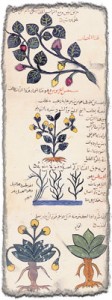
Khawass al-Ashjar, Arabic version of De Materia Medica.
www.islamicmedicine.org/natural.htm
Int. Society for the History of Islamic Medicine
Pedanius Dioscorides (Greek: Πεδάνιος Διοσκορίδης; ca. 40-90) was an ancient Greek physician, pharmacologist and botanist from Anazarbus, Cilicia, Asia Minor, who practised in ancient Rome during the time of Nero. He had the opportunity to travel extensively seeking medicinal substances from all over the Roman and Greek world. Dioscorides wrote a five-volume book in his native Greek, Περί ὕλης ἰατρικής (De Materia Medica in the Latin translation; Regarding Medical Matters) that is a precursor to all modern pharmacopeias, and is one of the most influential herbal books in history. In fact, it remained in use until about CE 1600. Unlike many classical authors, his works were not „rediscovered“ in the Renaissance, because his book never left circulation. The De Materia Medica was often reproduced in manuscript form through the centuries, often with commentary on Dioscorides‘ work and with minor additions from Arabic and Indian sources, though there were some advancements in herbal science among the Arabic additions. The most important manuscripts survive today in Mount Athos monasteries. DE MATERIA MEDICA is important not just for the history of herbal science: it also gives us a knowledge of the herbs and remedies used by the Greeks, Romans, and other cultures of antiquity. The work also records the Dacian and Thracian names for some plants, which otherwise would have been lost. The work presents about 600 plants in all, although the descriptions are obscurely phrased. Duane Isely notes that „numerous individuals from the Middle Ages on have struggled with the identity of the recondite kinds“, and characterizes most of the identifications of Gunther et al. as „educated guesses“. Read More: > HERE <
Medicine was the first of the Greek sciences to be studied in depth by Islamic scholars. During the ninth century and into the tenth, the spiritual head of Islam, Harun al-Rashid (of Arabian Nights fame), and his son, al-Ma’mun, sent embassies to collect Greek and other scientific works from throughout the region. These were taken to the “House of Wisdom,” where the entire body of Greek medical texts, including all the works of Galen, Oribasius, Paul of Aegina, Hippocrates, and Dioscorides, were translated into Arabic—manuscripts so important that one of the translators was paid for each translation by its equivalent weight in gold.
Arab pharmacopoeia came from so many sources—as far afield as China, Southeast Asia, the Himalayas, southern India, and West Africa—it was enormous. In his second volume of the Canon of Medicine, Ibn Sina (a.d. 980–1037, also known as Avicenna) describes 235 remedies, of which 97 still appear in the official British Pharmacopoeia, as well as 760 medicinal plants and their uses. Ibn Sina also laid out the rules that are the basis of clinical trials today.
Sesam Oil and tamarind not only used in Ayurveda: Like most medieval medicine, the Islamic viewpoint was an outgrowth of Galen’s Humoral Theory and focused on the need to balance the humors, or bodily fluids.
Cathartics, purges, and laxatives were considered essential to this goal. The most popular herb—an enduring favorite today—was senna, a low bush with small yellow flowers, greenish yellow leaves, and fat seed pods. The leaves have a distinctive smell, and the infusion made from them has a nauseatingly sweet taste; taken alone, the infusion does indeed produce nausea. The Arabs calmed both taste and effect by adding aromatic spices.
The Arabs also introduced manna and tamarind as safe, mild, and reliable laxatives. Scammony, a climbing plant of the morning glory family that has thick roots with medicinal value, was a controversial herb in Europe, where some practitioners declared its violent laxative action unsafe to use under any conditions, while others said they could not function without it. Islamic pharmacists responded by devising a reliable preparation to temper the herb’s ferocity but retain its potency. They did this by first boiling the scammony root inside a fruit called a quince; the scammony was then discarded and the quince pulp mixed with the soothing, gooey seeds of psyllium. The preparation was known as “diagridium.”
Formulation developed into an art involving many steps and ingredients. Ar-Razi, Islamic medicine’s greatest clinician and most original thinker, combined bitter almonds with an ounce of raisin rob, or pulp, to treat kidney stones. For the same ailment, a clinician named Haly Abbas recommended boiling jujubes, fruits of sebesten, white maude, and seeds of smallage, fennel, caltrop, and thyme.
In addition to compounds, the Arabs valued hundreds of simple herbal remedies. They used sesame oil to relieve coughs and soften rawness of the throat. Juice from the stalk and leaves of the licorice plant was considered good for respiratory problems, swollen glands, and clearing the throat, whereas the root was used to treat foot ulcers and wounds.
Myrrh, primarily known in the West as a gift from one of the Three Wise Men, was highly valued for its medicinal properties as an astringent and was also used to treat dyspepsia, chronic bronchitis, leukorrhea, and as a topical application in gum disease. In fact, it is a primary ingredient in many commercial mouthwashes today.
An Ancient Tradtion survived: Arab pharmacology was not only extensive but also the strongest empirically based biological science. Ibn Sina’s Canon laid out the basic rules of clinical drug trials, ones that are still followed today: A drug being tested must be pure, and it must work on all cases of the disease. Testing in humans, with careful notation of the drug’s effectiveness under different conditions, was the necessary final step. Observation and experimentation were the sole determinants of the value (or lack of value) of a potential treatment.
Not surprisingly, when Europe began to stir from a thousand years of intellectual slumber, it turned to the Islamic world. It was no coincidence that Salerno, Europe’s first great medical center, was close to Arab Sicily, or that the first outstanding medical university, Montpellier, was located in southern France, near the Andalusian border.
AYURVEDA, TRIPHALA, BITTERSTOFFE
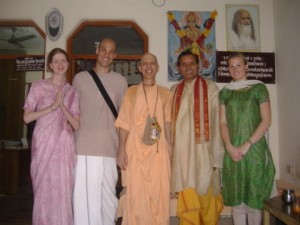
(Iskcon Devotees at Pulsediagnosis)
> HILDEGARD MAITRUNK FRÜHLINGSKUR <
> AYURVEDISCHE REINIGUNGSMASSNAHMEN <
Triphala is an Ayurvedic herbal RASAYANA formula consisting of equal parts of three myrobalans, taken without seed: Amalaki (Emblica officinalis), Bibhitaki (Terminalia bellirica), and Haritaki (Terminalia chebula), with potential anti-cancer properties. The word triphala (better triphalÄ�, from Hindi/Sanskrit: त्रिफला, pronounced [trɪˈpʰɐlɑ], widely mispronounced [triˈfɑːlə] or [triˈfæːlə] among English speakers) means literally “three fruits”. Read More: > HERE <
-
madhura–süß
-
amla– sauer
-
lavana–salzig
-
katu–scharf
-
tikta–bitter
-
kashai–herb
Für eine optimale Gesundheit und eine optimale Ernährung sollten die sechs Geschmacksrichtungen in einem ausgewogenen Verhältnis in der Nahrung vorhanden sein.
Dieses ayurvedische Prinzip der sechs Geschmacksrichtungen nimmt auch eine Schlüsselstellung in der Wissenschaft der Zubereitung ayurvedischer Kräuterpräparate ein. Menschen, die Pitta und Kapha ausgleichen müssen, sollten allgemein mehr bittere und herbe Nahrungsmittel zu sich nehmen.
Die ayurvedischen Churnas bzw. Gewürzmischungen sind eine praktische und bequeme Art, diese Geschmacksrichtungen in die Ernährung zu integrieren. Die westliche Ernährungsweise neigt hauptsächlich zu süßen und saueren Geschmacksrichtungen. Zu den süßen Nahrungsmitteln rechnet man Weizenprodukte wie z.B. Brot, Zerealien (Haferflocken, Müsli) und Nudeln, außerdem Reis, Milch, Eis und andere Süßspeisen.
Zu den saueren Nahrungsmitteln gehören Nahrungsmittel, die aus Tomaten hergestellt wurden wie Ketchup und Nudelsaucen, außerdem Käse, Zitrusfrüche und sauere Fruchtsaftgetränke. Zu viel von diesen saueren Nahrungsmitteln erzeugen zu viel Hitze im Körper und Menschen mit Übersäuerung oder anderen Anzeichen eines Pitta-Ungleichgewichts sollten diese reduzieren oder möglichst vermeiden. Bitteres trägt dazu bei, Pitta und Kapha auszugleichen. Es reduziert die Wasserspeicherung und wird als Stärkungsmittel für eine blockierte Leber verwendet. Es reinigt und trägt dazu bei, Brennen und Jucken zu verringern. Im Übermaß angewendet, kann es Vata erhöhen und den Körper austrocknen. Herbe Nahrungsmittel reinigen das Blut und tragen ebenfalls zum Ausgleich von Pitta und Kapha bei, im Übermaß erzeugen sie Gase und Verstopfung.
Beispiele für Nahrungsmittel und Gewürze mit bitterem und herbem Geschmack:
-
Bitter: Bittermelone und Kürbis· Japanische Aubergine· Kurkuma (Gelbwurz)· Bockshornkleesamen· grünes Blattgemüse· Gerste· Basilikum· Brennessel· Kopfsalat· Aloe Vera
-
Herb: Apfel· Granatapfel (schmeckt sauer auf der Zunge, ist aber sowohl herb als auch bitter)· Birne· Quinoa· Hülsenfrüchte· Tofu· Sprossen· Bohnen
Versuchen Sie, einige dieser Nahrungsmittel in Ihren täglichen Speiseplan aufzunehmen. Eine einfache Art, den bitteren Geschmack zu integrieren, ist es, dem Essen beim Kochen Bockshornkleesamen zuzufügen. Ein Teelöffel Bockshornkleesamen pro Tag ist eine sehr gute Art, mehr von dem ausgleichenden bitteren Geschmack im Essen zu haben. Sie können sie in Ghee anbraten und dann Ihr Gemüse zufügen oder Sie geben sie einfach während des Kochens zu.
Kurkuma (Gelbwurz) ist sowohl bitter als auch herb. Es wird als blutreinigend und antioxidant angesehen. Ein Teelöffel davon pro Tag, den Sie in Ihrem Essen mitkochen, ist eine ausgezeichnete und billige Gesundheitsvorsorge und ist eine wunderbare Art, Ihre Aufnahme an Antioxidantien zu erhöhen.Granatapfelkerne schmecken sauer, sind aber sowohl herb als auch bitter und sind nicht pitta-erhöhend.
In den ayurvedischen Schriften werden Granatapfelkerne als pittaausgleichende Früchte und als wunderbares Herzstärkungsmittel bezeichnet. Aus Granatapfelkernen kann man leckere Tunke und Chutneys machen, die man täglich essen kann, besonders im Sommer, wenn das Pitta Dosha leicht aus dem Gleichgewicht gerät.
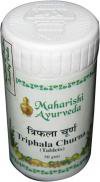
-
Triphala corrects constipation, cleanses and tonify the gastro intestinal tract.
-
Detoxifies the whole body and improves digestion and assimilation
-
Triphala reduces high blood pressure and hypertension and improves blood circulation.
-
Very effective in Irritable bowel syndrome and ulcerative colitis.
- Highly anti inflammatory, anti viral and also stimulates bile flow and peristalsis.
- Triphala is also helpful in liver disorders, acts as an expectorants and corrects diverticulitis. ( Diverticulosis )
-
Dose – 2-2 tablets after lunch and dinner ( before sleeping ) with luke warm water.
Many companies now a day making triphala but its my own believes Maharishi Triphala tablets are best. And have excellent result compare to other Companies and they are not expensive just 10$ cost for 100 tablets.
For any information, question , doubt, quarries, can mail me any time or put question on wall .. also for your suggestion can put in wall.. all information that is transformation of knowledge..
> AYURVEDA4UALL… AT FACEBOOK. <
> RASAYANA in der Ayurvedatherapie <
vaidyajitripathi@gmail.com
can send me text.
+91-9958504088
> Dein Ayurveda Net: ….. > Ayurveda, Ursprung, Geschichte <
> Meet Herbals and Naturals and friends at facebook <
> Meet all Ayurveda Groups, Friends, Studies at facebook <
> Meet Lord Dhanvantri at facebook <
> HAPPY BIRTHDAY SWAMI JI…..
KASHMIRI OVERSEAS ASSOCIATION, INC.
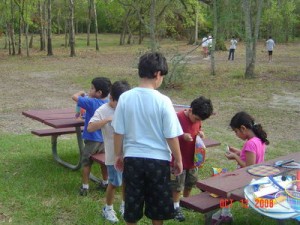
> SAVE A SMILE, Sponsor a Child <
> KASHMIR SHIVAITEN IM HIMALAYA <
> Kashmiri Overseas Association USA <
The KOA organization has its origins in the early meetings of several Kashmiri > Pandit < families in the Washington D.C. and Maryland areas. These families soon came to realize the importance of building a community structure which could include other families too in a bond for mutual preservation and growth. As more families and members joined the founding group, the organization evolved to become a national outfit with regional chapters, documented bye-laws, systems and procedures as well as a non-profit status to better seek donations and pursue community actions.
The KOA Community: > * H E R E *<
Shriya Bhat Mission Hospital and Research Center: Since then the hospital is working as a multi-disciplinary clinic. Over the years some amenities have been added like an air conditioner, refrigerator, ECG machines, glucometers, nebulizers, traction apparatus etc. A medical van has been kept at the disposal of the sick patients. The Center is open to every body irrespective of cast or creed, region or religion.
There is a work force of consultants in internal medicine, neurology, general surgery, urology, orthopedics and dermatology in regular attendance. Patients are registered for examination and treatment round the week. The mission hospital has so far rendered its services to more than 35 thousand patients. All the patients receive a free 3-4 week supply of available medicines. A mini laboratory helps with some basic investigations, again conducted free on the patients.
Sharda Peeth Rishi Model School, Udhampur, J&K: In 1990, terrorism and sectarian violence caused nearly 500,000 Kashmiri Hindus to flee the land of their ancestors, the fabled valley of Kashmir in the Indian state of Jammu and Kashmir. These victims of terrorism, refugees in their own country, left behind virtually all of their worldly possessions as they had to flee under threat to life and honor.
As in most situations, the worst sufferers of this violence were the children of this displaced people. With their parents consumed with, yet often unable to, provide the basics of living to their families these unfortunate children were often left without the only hope for a better life – a healthy education.
The Rishi Memorial School was started in the mid-1990s with contributions from a group of US-based Indian-Americans concerned for the future of these indigent children. This remarkable experiment in social self-service began with only about a dozen students and one teacher.
Save a Smile – Sponsor a Child: The refugee camps in Jammu and Kashmir house hundreds of thousands of Kashmiri Pandits displaced from their homes as a direct result of the Islamic militancy in the valley. This tragedy has resulted in children being denied the opportunities that we take for granted. Since 1995, the Kashmiri Overseas Association, USA has implemented the Sponsor-A-Child Program for the age group 5 year olds to 17 year olds. This program aims to provide educational opportunities to the children directly affected by the tragedy. While individuals worldwide have contributed to these programs more children are in need of our financial support than currently available funds can support, there are many more that deserve our assistance. Goal: To provide tuition, school supplies and living expenses to school children who are currently living in refugee camps.
Religion – The religious practices of Hindus of Kashmir (popularly known as Kashmiri Pandits) revolve around the worship of Shiva and Shakti. All other deities (gods and goddesses) of the traditional Hindu pantheon are worshipped as various manifestations of Shiva and Shakti. Shiva is the Supreme Lord of the universe and Shakti, the Universal Mother Goddess, is his eternal companion.
Region Kashmir: Poetry of Nature – Set like a jewelled crown on the map of India, Kashmir is a many-faceted diamond, changing its character with the seasons always extravagantly beautiful. Three Himalayan ranges – Karakoram, Zanskar and Pir Panjal – snow-capped, majestic, frame the landscape from northwest to northeast. They are the birthplace of great rivers which flow down into the valleys below, forested with wild orchards and lily laden lakes.
BYO, Yogaverband Österreich: www.yoga.at : > ”Eintreten in das göttliche Bewusstsein” < , Ref.: Bettina Bäumer, Ort: St. Virgil Salzburg, 23.07.10 – 25.07.10
- Programs: http://koausa.org/koa/
- Sponsor-A-Child
- Educational Assistance Program
- Rishi Memorial School
- Medical Funds
- Shriya Bhatt Mission Hospital
- Achievement Awards
- Awards & Recognitions
- Success Stories
- Projects
- Downloads
- Official Records
- Applications & Brochures
- Publications
- Newsletters
- and more…
Umrao Singh Memorial School (USMS)

www.ewasa.org , > e-waste <
> UMRAO SINGH MEMORIAL SCHOOL <
Our work started in the early 1980s with the planting of fruit trees in India. The emphasis was on creating awareness, training people to plant and take care of trees, and providing them with the resources needed to accomplish their tasks. Each recipient made a pledge to help at least two others in the same manner in which they had been helped.
The program grew rapidly in India and spread to Guatemala, Cambodia, Nepal, Costa Rica, Haiti, Indonesia, Brazil, Mexico, Ethiopia, Nicaragua, and El Salvador. As a result, tens of millions of fruit trees have been planted.
But far more important than the number of trees planted is the fact that tree planting inspires many people to do more to help themselves. They have started projects on bee-keeping, fuel-efficient stoves, improvement of their soils, water conservation, scientific improvement of plant breeding materials, self-help loans, improvement of medical facilities, improvement of educational facilities, and other socially responsible activities.
A large portion of funding and resources for activities in each country is generated locally. These resources are mostly provided in terms of land, labor, and in-kind contributions from various segments of the society. The international funds and resources provide key elements that are lacking locally.
We realize that our task is not to solve the problems of the world. Our challenge is to create a few demonstrable models that, if successful, may inspire others to solve their own problems. In this manner we are akin to a laboratory where an antidote to a disease may be developed. We are not a factory where the antidote is manufactured for sale.
Our focus is on developing and providing the tools of empowerment to local community leaders who can create hope among others. Empowerment in our case means:
Awareness + Networking of resources, which lead to → Action
GIFT´s FROM THE HEART: > HERE <
Our Initiatives:
- Books for Life International – spreading the joy of reading to children in developing countries worldwide.
- The Moringa Tree – encouraging the use of this miraculous tree and further research into its benefits.
- Education – empowering the poor to reach long-term goals through quality education.
- Fruit trees – helping provide a long-term and renewing source of food to the hungry of the world.
- Fuel-efficient cookstoves – saving lives with these cookstoves built with local materials by local residents.
- Trees for Life Journal – bringing beneficial plants and trees to the attention of the scientific community.
